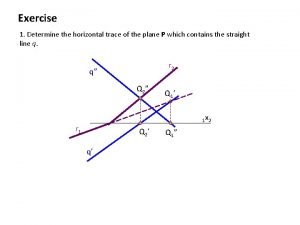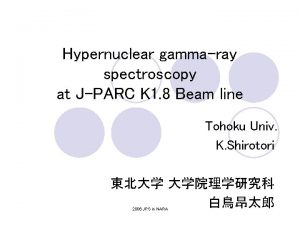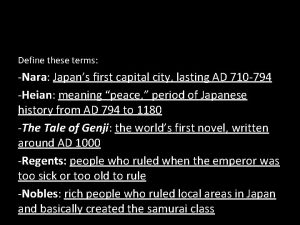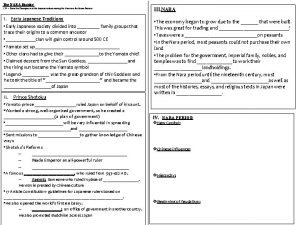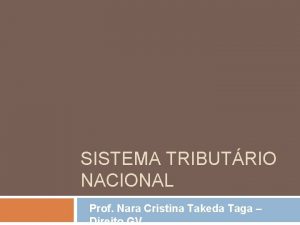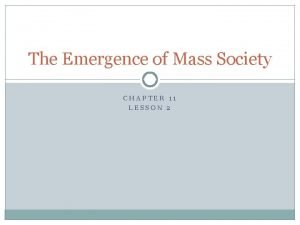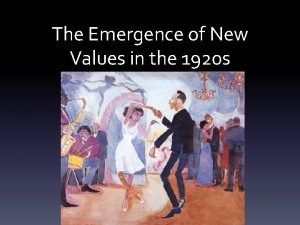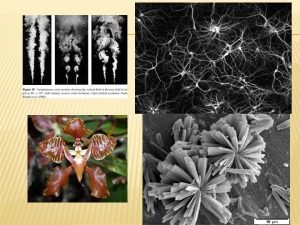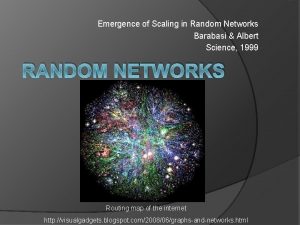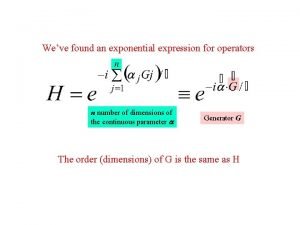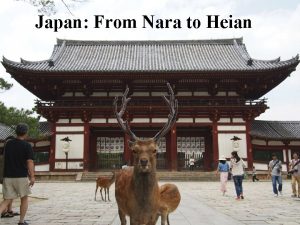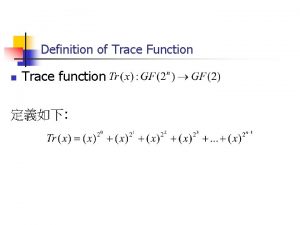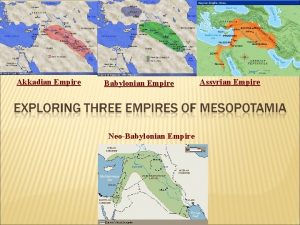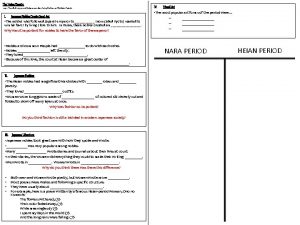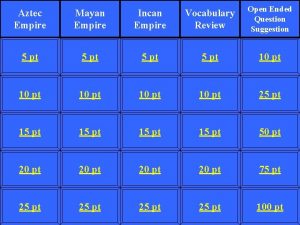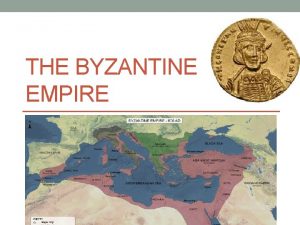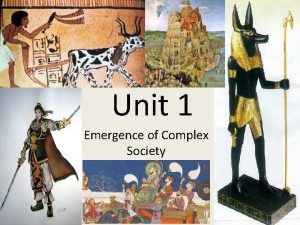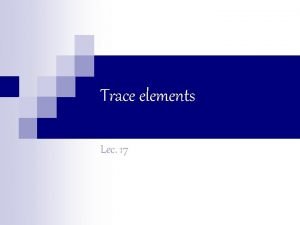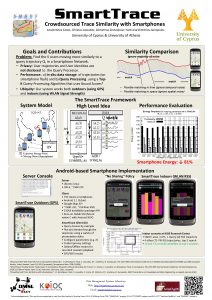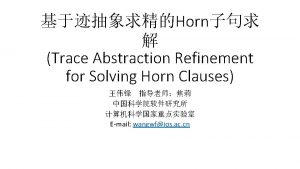The NARA Empire 7 29 Trace the Emergence
































- Slides: 32

The NARA Empire 7. 29 – Trace the Emergence of the Japanese nation during the Nara and the Heian Periods. I. Early Japanese Traditions • Early Japanese society divided into _____ family groups that trace their origins to a common ancestor • ______clan will gain control around 500 CE • Yamato set up_________________ • Other clans had to give their _______to the Yamato chief. • Claimed descent from the Sun Goddess, ________and the rising sun became the Yamato symbol • Legend-______ was the great-grandson of this Goddess and he took the title of “___________” and became the __________of Japan II. Prince Shotoku • Yamato prince _________ruled Japan on behalf of his aunt. • Wanted a strong, well-organized government, so he created a ___________(a plan of government) • _____________will be very influential in spreading _______________and ___________ • Sent missions to _________to gather knowledge of Chinese ways • Shotoku’s Reforms – _____________________ – Made Emperor an all-powerful ruler – _____________________ • A famous ____________, who ruled from 593 -622 AD. – Regent: Someone who ruled in place of _________. He was impressed by Chinese culture • 17 Article Constitution- guidelines for Japanese rulers based on ___________________________. • He also opened the world’s first embassy. – _______: an office of government in another country. He also promoted Buddhism across Japan III. NARA • The economy began to grow due to the _______ that were built. This was great for trading and ______________! • Taxes were a _______________on peasants • In the Nara period, most peasants could not purchase their own land • The problem for the government, imperial family, nobles, and temples was to find _______ to work their __________landholdings. • From the Nara period until the nineteenth century, most __________and ____________as well as most of the histories, essays, and religious texts in Japan were written in _________. IV. NARA PERIOD v. New Capital: v. Chinese influence: v. Hierarchy: v. Beginning of feudalism:

The Heian Empire 7. 29 – Trace the Emergence of the Japanese nation during the Nara and the Heian Periods. I. Japanese Nobles Create Great Art • The nobles who followed Japan’s emperor to______ (now called Kyoto) wanted to win his favor by living close to him. In Heian, these nobles created an ________. Why was it important for nobles to have the favor of the emperor? • Nobles and Common People had _______ to do with each other. • Nobles _________ left the city. • They loved_________________. • Because of this love, the court at Heian became a great center of ____________________________. II. Japanese Fashion • The Heian nobles had magnificent wardrobes with ____ robes and _____ jewelry. • They loved __________ outfits. • Women wore long gowns made of _________ of colored silk cleverly cut and folded to show off many layers at once. Why was fashion so important? III. Japanese Literature • Japanese nobles took great care with how they spoke and wrote. • ______ was very popular among nobles. • Many ________ wrote diaries and journals about their lives at court. • In their diaries, the women did everything they could to make their writing _____. • Men wrote in ______. Women wrote in __________. Why do you think there was there this difference? • Both men and women wrote poetry, but women wrote more ______. • Most poems were Wakas and following a specific structure. • They were usually about ______________. • For example, here is a poem written by a famous Heian-period woman, Ono no Komachi: The flowers withered, (5) Their color faded away, (7) While meaninglessly (5) I spent my days in the world (7) And the long rains were falling. (7) IV. Visual Art • The most popular art forms of the period were… – ______________________________________________________ – ___________________________ Do you think fashion is still a bid deal in modern Japanese society?

NARA PERIOD HEIAN PERIOD

DO NOW— Answer: Based on this picture and caption, what assumption can you make about Japanese life in the Nara period? Explain your answer. That’s over 49 feet high

Knowledge check! • 1. How would you describe Shintoism? • 2. How would you describe the teachings of Buddha?

DO NOW 12/13/2017 • • • Define the following terms: Shogun (226) Vassals (227) Feudalism (227) Guilds (228) Zen (229)

Japan Lesson I can trace the emergence of the Japanese nation during the Heian period. SPI 7. 29 Trace the emergence of the Japanese nation during the Nara, 710 -794, and the Heian periods, 794 -1180. http: //www. ck 12. org/user: a 2 Fy. ZW 4 ub. GF 3 c 29 u. QHRjc 2 Vkd. S 5 u. ZXQ. /book/Tennessee-7 th-Grade-Social. Studies-World-History%253 A-the-Fall-of-Rome-to-the-Age-of-Exploration/section/6. 3/ https: //docs. google. com/presentation/d/1 u. Szs. T 0 EFSp. DWn. Lo 3 Hq. SNKp. Pj 6 BDEzz 4 uzg. K 65 mb. QQY/edit#slide=id. p 20

Learning Target • I can trace and evaluate the Heian and the Nara time periods of Japan. • I know I have it when I can debate which time period was the greatest and why.

Early Japanese Traditions • Early Japanese society divided into clans- family groups that trace their origins to a common ancestor • Yamato clan will gain control around 500 CE • Yamato set up Japan’s first and only dynasty • Other clans had to give their loyalty to the Yamato chief. • Claimed descent from the Sun Goddess, Amaterasu and the rising sun became the Yamato symbol • Legend-Jimmu was the great-grandson of this Goddess and he took the title of “emperor of heaven” and became the 1 st emperor of Japan

Early Japanese Traditions • Yamato prince Shotoku ruled Japan on behalf of his aunt. • Wanted a strong, well-organized government, so he created a Constitution (a plan of government) • Prince Shotoku will be very influential in spreading Chinese culture and Buddhism • Sent missions to Tang China to gather knowledge of Chinese ways • Shotoku’s Reforms – Created a Constitution – Made Emperor an all-powerful ruler – Modeled government on that of China’s

Prince Shotoku • A famous regent, who ruled from 593 -622 AD. – Regent: Someone who ruled in place of someone else. He was impressed by Chinese culture • 17 Article Constitutionguidelines for Japanese rulers based on Confucian Principles • He also opened the world’s first embassy. – Embassy: an office of government in another country. He also promoted Buddhism across Japan

When was the Nara Period? When was the Heian Period?

Nara • Almost 100 years after the death of Prince Shotoku, the capital of Japan was set up in Nara. • A Buddhist monk named Dokyo tried to use other monks to gain power. Dokyo was also the chaplain to the empress of the time. He used her to further his ambitions.

Nara Period (710 -794) • Nara period in Japanese history was a period in which the imperial government was located in Nara, Japan. • There is still a city named Nara in Japan today. • Buddhism was most highly developed in Nara. • Nara artisans made refined Buddhist sculptures and erected grand Buddhist temples.

Nara economy • The economy began to grow due to the roads that were built. This was great for trading and transportation!

Nara Government • Until the eighth century, the capital usually moved each time an emperor died. • Then, in 710, a new capital, intended to be permanent, was established at Nara. • But then, it moved again—some say to escape the meddling in politics of powerful Buddhist temples. http: //www. pearsonhighered. com/assets/hip/us/hip_us_pearsonhighered/samplechapter/0136005241. pdf

NARA People, Land, and Taxes • Taxes were a heavy burden on peasants • In the Nara period, most peasants could not purchase their own land • The problem for the government, imperial family, nobles, and temples was to find labor to work their extensive landholdings. http: //www. pearsonhighered. com/assets/hip/us/hip_us_pearsonhighered/samplechapter/0136005241. pdf

Education in Nara • From the Nara period until the nineteenth century, most philosophical and legal writings as well as most of the histories, essays, and religious texts in Japan were written in Chinese.

THE NARA PERIOD (710 -794) v New Capital: v A. D. 700 s the Emperors built a new capital city at Nara v Chinese influence: v Buddhist and Shinto shrines and Chinese style homes v Hierarchy: • Officials ranked by hierarchy by social status (powerful families in government positions) • No civil service exam v Beginning of feudalism: • Government officials given land for services • Emperor controls the land making him very powerful Buddhism reaches Japan from Korea (CULTURAL DIFFUSION!)

Summary #1 Think, Share, Ink • Why did the dynasty move itself from Nara to Heian?

Heian Period 794 -1185 • Last division of classical Japanese history! • There used to be a city named Heian (now Kyoto) when the emperor moved there. • Buddhism was at its height! https: //www. youtube. com/watch? v=tiwh. I 1 Ouo. Wo

Heian Period • Capital moved to Heian (now named Kyoto) to put distance between imperial family and the clans that admired Dokyo in Nara. • Japanese began to distance themselves from Chinese influence and alter calligraphy and Buddhism to reflect Japanese culture. • The Fujiwara family managed to control the political scene of the Heian period over several centuries through strategic intermarriages with imperial family AND occupying all the important political offices in Kyoto and major provinces. Peak 1016. • Aristocratic power began to decline, and public order could not be maintained. Many land owners hired samurai for the protection of their properties. That is how the military class became more and more influential, especially in Eastern Japan.

Japanese Nobles Create Great Art • The nobles who followed Japan’s emperor to Heian (now called Kyoto) wanted to win his favor by living close to him. In Heian, these nobles created an imperial A group of nobles who court. live near and serve or advise a ruler Why was it important for nobles to have the favor of the emperor?

Japanese Nobles Create Great Art • Nobles and Common People had little to do with each other. • Nobles seldom left the city. • They loved beauty and elegance. • Hmm…sounds familiar. • Because of this love, the court at Heian became a great center of culture and learning. • Sounds very familiar.

Japanese Fashion • The Heian nobles had magnificent wardrobes with silk robes and gold jewelry. • They loved elaborate outfits. • Women wore long gowns made of 12 layers of colored silk cleverly cut and folded to show off many layers at once. Why was fashion so important? Do you think fashion is still a big deal in modern Japanese society?

Japanese Literature • Japanese nobles took great care with how they spoke and wrote. • Writing was very popular among nobles. • Many women wrote diaries and journals about their lives at court. • In their diaries, the women did everything they could to make their writing beautiful. • Men wrote in Chinese. Women wrote in Japanese. – Why do you think there was there this difference?

Literature • Both men and women wrote poetry, but women wrote more prose. • Most poems were Wakas and following a specific structure. • They were usually about love or nature. • For example, here is a poem written by a famous Heian-period woman, Ono no Komachi: The flowers withered, (5) Their color faded away, (7) While meaninglessly (5) I spent my days in the world (7) And the long rains were falling. (7)

Visual Art • The most popular art forms of the period were… – Paintings – Calligraphy – Architecture

Heian Period: (794 -1158) Taxation system too weak – – decay of central authority Great families don’t pay taxes Small landholders can’t afford taxes Grants to temples (also tax exempt) Great families emerge and govern in their realms – Japan’s Feudal System emerges – Great families hire professional retainers for protection as a private army – Samurai is created

Heian- Golden Age • Fashion- a love for elaborate outfits • Literature- writing was very popular. Poetry was also popular. Men wrote in Chinese and Women wrote in Japanese.

The Heian = The Golden Age of Arts https: //www. youtube. com/watch? v=IAb. Qac. Ga 8 KU

EXIT TICKET—COMPLETE THE T-CHART HEIAN PERIOD NARA PERIOD Let’s review! What are you going to write about the Heian Period in Japan?
 Horizontal trace
Horizontal trace Nara licensing
Nara licensing Nara images
Nara images What is japans capital city
What is japans capital city Nara records management training
Nara records management training Nara images
Nara images Saorm
Saorm Nara images
Nara images Nara records retention policy
Nara records retention policy How would you describe the new capital city nara
How would you describe the new capital city nara Arcis nara
Arcis nara Nara takeda
Nara takeda Nara women’s university
Nara women’s university How would you describe the new capital city, nara?
How would you describe the new capital city, nara? Byzantine empire vs roman empire venn diagram
Byzantine empire vs roman empire venn diagram American empire vs british empire
American empire vs british empire Mauryan empire and gupta empire venn diagram
Mauryan empire and gupta empire venn diagram Emergence of entrepreneurial class in india
Emergence of entrepreneurial class in india Lesson 2 the emergence of mass society
Lesson 2 the emergence of mass society So&e
So&e Speech emergence
Speech emergence The emergence of new values
The emergence of new values Emergence
Emergence Plan emergence madagascar 2019-2023 pdf
Plan emergence madagascar 2019-2023 pdf Paul ruthman committee
Paul ruthman committee Plan emergence madagascar 2019-2023 pdf
Plan emergence madagascar 2019-2023 pdf Speech emergence examples
Speech emergence examples Emergence netflix
Emergence netflix Emergence theory
Emergence theory The emergence of mass society
The emergence of mass society Itero göteborg
Itero göteborg Emergence of scaling in random networks
Emergence of scaling in random networks Trace of a matrix
Trace of a matrix
